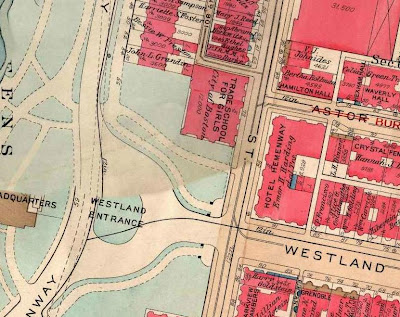
The Leslie Jones collection is a great resource of photographs held by the Boston Public Library. I tried to choose signs that could be identified with a company or location. The first photo features a plow and a sign for the Thomas Grey Company. The Boston Directory lists them as an agriculture warehouse and seed store. I've seen an Ebay listing for a seed catalogue as late as 1941. The address is 32 South Market and 19 Chatham street. This would have been opposite the center of today's Quincy Market.
 Smith the Hatter was at 30 Exchange street, which continued Congress street across State street to Dock square. You could probably see the Old State House from the front of the building.
Smith the Hatter was at 30 Exchange street, which continued Congress street across State street to Dock square. You could probably see the Old State House from the front of the building.

 Smith the Hatter was at 30 Exchange street, which continued Congress street across State street to Dock square. You could probably see the Old State House from the front of the building.
Smith the Hatter was at 30 Exchange street, which continued Congress street across State street to Dock square. You could probably see the Old State House from the front of the building.
This substantial block was on a corner of Atlantic avenue - note the elevated line to the right - and of course signified marine equipment for sale. This photo was dated 1929.
 There was a Regal Shoe Company, Inc, with offices on Summer street and locations on Washington and Tremont streets.
There was a Regal Shoe Company, Inc, with offices on Summer street and locations on Washington and Tremont streets. 
Charles C. Hutchinson sold nautical instruments at 152 State street, and sure enough we see the '2' at the lower left. Mercury, with his winged feet and caduceus, stands on a ball carved '1861.'
 The saw above McMahon and Jaques at 242 Massachusetts ave is a bit of a puzzle, as I find them listed in the 1925 Directory as plumbers. This address fronted on Massachusetts avenue directly in front of the Christian Science mother church - the row is gone now.
The saw above McMahon and Jaques at 242 Massachusetts ave is a bit of a puzzle, as I find them listed in the 1925 Directory as plumbers. This address fronted on Massachusetts avenue directly in front of the Christian Science mother church - the row is gone now. 
This sign representing law books sat above 26 Pemberton square. Suffolk County Court House had replaced one side of Pemberton square, and the other became the home to Barrister's Hall, and other law-related facilities.

Horses were auctioned off at 42 Traverse street, which appropriately cut across the Bullfinch Triangle.
 Montgomery Frost Company sold glasses at 366 Boylston street between Arlington and Berkeley streets. Apparently, they are still in business as Montgomery Frost Lloyds.
Montgomery Frost Company sold glasses at 366 Boylston street between Arlington and Berkeley streets. Apparently, they are still in business as Montgomery Frost Lloyds.
This was listed as the Cole Piano Company built I couldn't find any references to it. The Bijou theatre sign behind the piano tells us that this was Washington street - the Bijou was at 545 Washington street, beside the Keith theatre.
 A collar pin represents the Rosenberg company's stock. It appears as if this was Rosenberg and Gordon, of 387 Washington street.
A collar pin represents the Rosenberg company's stock. It appears as if this was Rosenberg and Gordon, of 387 Washington street. I can't find a location for Boston Gears, but I do love that sign.
I can't find a location for Boston Gears, but I do love that sign.
George Connolly's marine and contractor's equipment company was at 14/16 Atlantic avenue.

And finally, Lang and Jacobs Coopers supply, 24 India square. India square was a street between Broad and India streets, just up from Atlantic avenue. The block was lost to the Central Artery. I saved this for last because my ancestor Nicholas Bulger, who came from Ireland and settled in St John's Newfoundland, his son and grandson were all coopers. One of them ended up settling in East Cambridge, where my father was born. So there but for the grace of God and technological advances, go I.






















